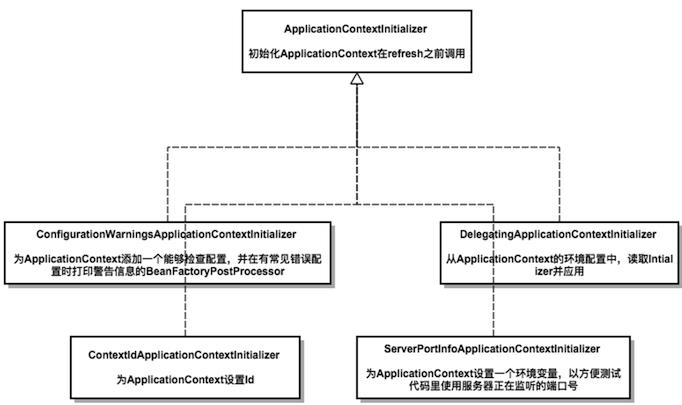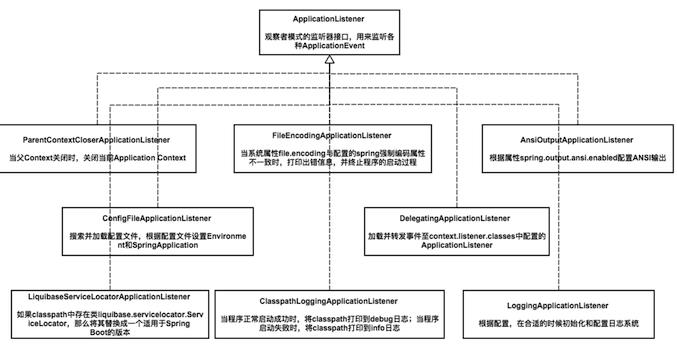附3 spring源码解析 - 构建SpringApplication
Posted 赵计刚
tags:
篇首语:本文由小常识网(cha138.com)小编为大家整理,主要介绍了附3 spring源码解析 - 构建SpringApplication相关的知识,希望对你有一定的参考价值。
1 package com.microservice.framework; 2 3 import org.springframework.boot.SpringApplication; 4 import org.springframework.boot.autoconfigure.SpringBootApplication; 5 6 @SpringBootApplication 7 public class MySpringAplication { 8 9 public void run(String[] args) { 10 SpringApplication sa = new SpringApplication(MySpringAplication.class); 11 sa.run(args); 12 } 13 14 }
SpringBoot启动过程:
1、构建SpringApplication对象
2、执行run()
一、构建SpringApplication对象
1 /** 2 * The application context will load beans from the specified sources 3 */ 4 public SpringApplication(Object... sources) { 5 initialize(sources); 6 }
说明:
- 实例化该类的时候会加载bean到applicationContext中去
- 这里的入参是MySpringApplication.class这样一个Class<com.microservice.framework.MySpringApplication>对象
private final Set<Object> sources = new LinkedHashSet<Object>(); private boolean webEnvironment; private Class<?> mainApplicationClass; private void initialize(Object[] sources) { if (sources != null && sources.length > 0) { this.sources.addAll(Arrays.asList(sources)); } this.webEnvironment = deduceWebEnvironment(); setInitializers((Collection) getSpringFactoriesInstances( ApplicationContextInitializer.class)); setListeners((Collection) getSpringFactoriesInstances(ApplicationListener.class)); this.mainApplicationClass = deduceMainApplicationClass(); }
步骤:
- 将传入的MySpringApplication.class对象放入Set集合
- 判断是否是web环境
- 创建ApplicationInitializer列表
- 初始化ApplicationListener列表
- 初始化主类mainApplicationClass
1.1、将传入的MySpringApplication.class对象放入Set集合
1.2、判断是否是web环境:
private static final String[] WEB_ENVIRONMENT_CLASSES = { "javax.servlet.Servlet", "org.springframework.web.context.ConfigurableWebApplicationContext" }; private boolean deduceWebEnvironment() { for (String className : WEB_ENVIRONMENT_CLASSES) { if (!ClassUtils.isPresent(className, null)) { return false; } } return true; }
说明:通过在classpath中查看是否存在WEB_ENVIRONMENT_CLASSES这个数组中所包含的所有类(实际上就是2个类),如果存在那么当前程序即是一个Web应用程序,反之则不然。
1.3、创建ApplicationContextInitializer列表
1 private List<ApplicationContextInitializer<?>> initializers; 2 3 public void setInitializers( 4 Collection<? extends ApplicationContextInitializer<?>> initializers) { 5 this.initializers = new ArrayList<ApplicationContextInitializer<?>>(); 6 this.initializers.addAll(initializers); 7 } 8 9 private <T> Collection<? extends T> getSpringFactoriesInstances(Class<T> type) { 10 return getSpringFactoriesInstances(type, new Class<?>[] {}); 11 } 12 13 private <T> Collection<? extends T> getSpringFactoriesInstances(Class<T> type, 14 Class<?>[] parameterTypes, Object... args) { 15 ClassLoader classLoader = Thread.currentThread().getContextClassLoader(); 16 17 // Use names and ensure unique to protect against duplicates 18 Set<String> names = new LinkedHashSet<String>( 19 SpringFactoriesLoader.loadFactoryNames(type, classLoader)); 20 List<T> instances = new ArrayList<T>(names.size()); 21 22 // Create instances from the names 23 for (String name : names) { 24 try { 25 Class<?> instanceClass = ClassUtils.forName(name, classLoader); 26 Assert.isAssignable(type, instanceClass); 27 Constructor<?> constructor = instanceClass.getConstructor(parameterTypes); 28 T instance = (T) constructor.newInstance(args); 29 instances.add(instance); 30 } 31 catch (Throwable ex) { 32 throw new IllegalArgumentException( 33 "Cannot instantiate " + type + " : " + name, ex); 34 } 35 } 36 37 AnnotationAwareOrderComparator.sort(instances); 38 return instances; 39 }
步骤:
- 调用SpringFactoriesLoader.loadFactoryNames(type, classLoader)来获取所有Spring Factories的名字,(这里是获取了四个ApplicationContextInitializer实现类的全类名,见下边)
- 为每一个Spring Factories根据读取到的名字创建其对象。(这里创建了4个对象)
- 将创建好的对象列表排序并返回。
其中,SpringFactoriesLoader.loadFactoryNames(type, classLoader)如下:
1 /** 2 * The location to look for factories. 3 * <p>Can be present in multiple JAR files. 4 */ 5 public static final String FACTORIES_RESOURCE_LOCATION = "META-INF/spring.factories"; 6 7 /** 8 * Load the fully qualified class names of factory implementations of the 9 * given type from {@value #FACTORIES_RESOURCE_LOCATION}, using the given 10 * class loader. 11 */ 12 public static List<String> loadFactoryNames(Class<?> factoryClass, ClassLoader classLoader) { 13 String factoryClassName = factoryClass.getName(); 14 try { 15 Enumeration<URL> urls = (classLoader != null ? classLoader.getResources(FACTORIES_RESOURCE_LOCATION) : 16 ClassLoader.getSystemResources(FACTORIES_RESOURCE_LOCATION)); 17 List<String> result = new ArrayList<String>(); 18 while (urls.hasMoreElements()) { 19 URL url = urls.nextElement(); 20 Properties properties = PropertiesLoaderUtils.loadProperties(new UrlResource(url)); 21 String factoryClassNames = properties.getProperty(factoryClassName); 22 result.addAll(Arrays.asList(StringUtils.commaDelimitedListToStringArray(factoryClassNames))); 23 } 24 return result; 25 } 26 catch (IOException ex) { 27 throw new IllegalArgumentException("Unable to load [" + factoryClass.getName() + 28 "] factories from location [" + FACTORIES_RESOURCE_LOCATION + "]", ex); 29 } 30 }
META-INF/spring-factories
1 # Application Context Initializers 2 org.springframework.context.ApplicationContextInitializer=\\ 3 org.springframework.boot.context.ConfigurationWarningsApplicationContextInitializer,\\ 4 org.springframework.boot.context.ContextIdApplicationContextInitializer,\\ 5 org.springframework.boot.context.config.DelegatingApplicationContextInitializer,\\ 6 org.springframework.boot.context.web.ServerPortInfoApplicationContextInitializer
说明:
- 从所有jar获取所有的META-INF/spring-factories文件。(这里只有spring-boot-1.3.0.RELEASE.jar下有一个)
- 遍历每一个spring-factories文件,并获取其下key为factoryClass.getName()(这里是入参
org.springframework.context.ApplicationContextInitializer)的value(这里有以上四个ApplicationContextInitializer实现类)
以上四个类的作用:

至此,设置ApplicationContextInitialize就完成了。
总结:整个setInitializers实际上就是初始化了SpringApplication的属性List<ApplicationContextInitializer<?>> initializers为一个ArrayList列表,该列表中有四个实例:
- ConfigurationWarningsApplicationContextInitializer的实例
- ContextIdApplicationContextInitializer的实例
- DelegatingApplicationContextInitializer实例
- ServerPortInfoApplicationContextInitializer实例
1.4、初始化ApplicationListener列表
1 private List<ApplicationListener<?>> listeners; 2 3 /** 4 * Sets the {@link ApplicationListener}s that will be applied to the SpringApplication 5 * and registered with the {@link ApplicationContext}. 6 * @param listeners the listeners to set 7 */ 8 public void setListeners(Collection<? extends ApplicationListener<?>> listeners) { 9 this.listeners = new ArrayList<ApplicationListener<?>>(); 10 this.listeners.addAll(listeners); 11 }
META-INF/spring-factories
1 # Application Listeners 2 org.springframework.context.ApplicationListener=\\ 3 org.springframework.boot.builder.ParentContextCloserApplicationListener,\\ 4 org.springframework.boot.context.FileEncodingApplicationListener,\\ 5 org.springframework.boot.context.config.AnsiOutputApplicationListener,\\ 6 org.springframework.boot.context.config.ConfigFileApplicationListener,\\ 7 org.springframework.boot.context.config.DelegatingApplicationListener,\\ 8 org.springframework.boot.liquibase.LiquibaseServiceLocatorApplicationListener,\\ 9 org.springframework.boot.logging.ClasspathLoggingApplicationListener,\\ 10 org.springframework.boot.logging.LoggingApplicationListener
以上八个listener的作用如下:

至此,整个setListeners方法结束,初始化了一个包含以上8个ApplicationListener实例的List集合。
1.5、初始化主类mainApplicationClass
1 private Class<?> mainApplicationClass; 2 3 private Class<?> deduceMainApplicationClass() { 4 try { 5 StackTraceElement[] stackTrace = new RuntimeException().getStackTrace(); 6 for (StackTraceElement stackTraceElement : stackTrace) { 7 if ("main".equals(stackTraceElement.getMethodName())) { 8 return Class.forName(stackTraceElement.getClassName()); 9 } 10 } 11 } 12 catch (ClassNotFoundException ex) { 13 // Swallow and continue 14 } 15 return null; 16 }
说明:获取main()方法所在的主类Class对象,并赋值给SpringApplication的mainApplicationClass属性。
至此,SpringApplication对象初始化完成了。
总结:整个SpringApplication初始化的过程,就是初始化了
- 一个包含入参MySpringApplication.class的sources的Set<Object>
- 一个当前环境是否是web环境的boolean webEnvironment
- 一个包含4个ApplicationContextInitializer实例的List
- 一个包含8个ApplicationListener实例的List
- 一个main方法所在的主类的Class对象。
注意:
本文基本参照http://zhaox.github.io/java/2016/03/22/spring-boot-start-flow 完成,该文的作者已经解析的很好了,我这里再抄一遍,只是为了加深记忆!!!
以上是关于附3 spring源码解析 - 构建SpringApplication的主要内容,如果未能解决你的问题,请参考以下文章
深入浅出 Spring Cache 使用与整合(附源码解析)
快速构建一个Spring Boot+MyBatis的项目IDEA(附源码下载)